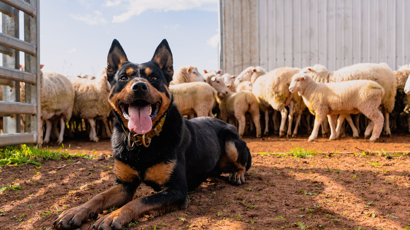Keeping sled dogs race ready

New Zealander Simon Kirkpatrick grew up around Old English Sheepdogs but it wasn’t until he moved to Australia in the early two thousands that he discovered the breeds that would steal his heart and introduce him to what’s become an extraordinary passion.
Nuts for running
Simon and his wife, Sheena, are the devoted owners of seven racing dogs: five Siberian huskies and two Malamutes (the ‘big rigs’ of the dog sledding world).
From late May to early September, the Kirkpatrick’s spend most weekends trucking their pack, dubbed the Take A Hike Sled Dog Team, from their rural home near Ballarat to competitions up and down the east coast and across South Australia.
The huskies run as a team on snow and dirt, pulling an all-terrain vehicle or sled, while the now retired Malamutes used to race as a pair. Courses can range from 1 kilometre up to 10 kilometres but the majority are five-10 kilometre ‘sprints’ depending on class.
It’s an exhilarating sport for mushers (the person or people who compete with their dogs). “I love being out in the middle of the bush or a ski field somewhere and it’s just the dogs and me – you can tell when they’re giving you everything they’ve got and see the sheer enjoyment they get out of doing it,” says Simon, who is a bicycle sales consultant by day.
It’s an enthusiasm that never diminishes. “Back home, you grab a harness in the morning and one of the dogs sees it and they just go nuts because they know what’s going to happen,” Simon says. “They’ll be in their kennels jumping five feet in the air with excitement about going for a run. You don’t get anywhere near that level of enthusiasm about anything else from an Arctic dog.”
Watching the team cross the finish line is equally rewarding, adds Sheena who, to date, has resisted the urge to take a turn with the lines.
“My favourite part of doing what we do is seeing them come home with smiles on their faces – Simon and the dogs!” she says.
“I like playing ‘mum’, looking after them and working with them afterwards while Simon does the training and the competitions.”
Racing on their stomachs
Huskies and Malamutes have been known to run up to 160 kilometres in a day on snow. Pulling heavy loads is in their DNA and a fit team can truck along for hours at a brisk 10-15 kilometres per hour.
While their capacity is significantly less in our humid climate, they still need to be in tip -top condition when racing shorter courses. Both breeds run on their stomachs and ensuring they receive the correct nutrients all year round is critical.
“Every day or two I’ll assess each dog’s body condition to see if they’re getting a bit too lean or a bit too tubby, and make corresponding adjustments to their food intake,” Simon says.
“We only have a small pre-season window – Australian temperatures don’t drop low enough for us to start training until April – and an overweight or unhealthy dog wouldn’t be able to lose enough weight in time, let alone build up the muscle mass they need to be safe to race.
“Out of shape animals are also more prone to foot and leg injuries so keeping them in peak condition is better for everyone concerned, but especially the dogs.”
A diet of high protein, high fat Black Hawk Working Dog kibble provides the huskies and ‘Mals’ with the nutrition they need without them having to consume large volumes of food.
“We feed twice a day,” Simon says. “In the morning, it’s a cup of Black Hawk Working Dog and then, in the evening, another one to two cups, depending on the dog and what we’re doing. Over summer, we’ll add some minced chicken frames for extra fat and protein every second day, and then in winter every day.”
It’s a formula that keeps his pack running fast and looking fabulous.
“The dogs’ coats looked a lot better after we switched to Black Hawk seven years ago,” Simon says. “With some of the other food we tried previously, their coats weren’t shiny and they didn’t feel nice – even the young dogs looked older.”
Carrying on the lines
While their dogs leave the Kirkpatrick’s little time for other interests, they love it that way.
“For us, racing is more than a weekend sport,” Sheena says. “People do say, ‘is it just a hobby?’ but our response is ‘no, it’s a lifestyle’. The dogs are only racing dogs for four months of the year but they’re your family for 12 months. Everything we do and love is about those pups.”
So much so that they’re planning to expand their pack in early 2023, with an inaugural litter from their kennel’s foundation bitch, Quinn. The pups will join the Take A Hike team as the couple’s older dogs transition to retirement.
“We have some great temperaments and personalities in our pack and we really want to carry those lines on,” Simon says. “Two of the huskies, Joker and Oak, won’t be able to keep up in a year or two and we’ll need dogs to replace them. For us, breeding won’t be about making money; whether Quinn has one puppy or eight, we’ll be keeping them all.”
Whether you have a sporting dog or a family pet, keeping them fit and healthy will allow them to live a more active, fulfilling life.


